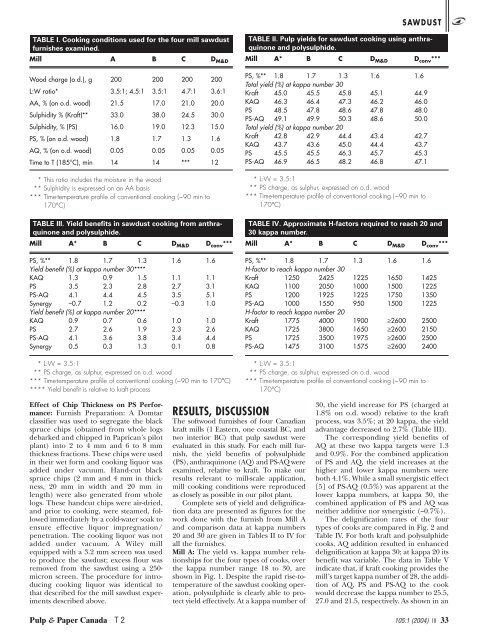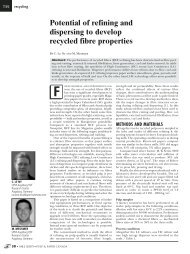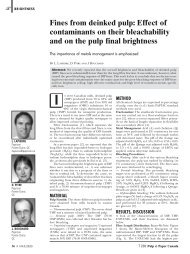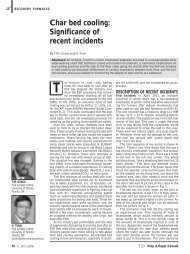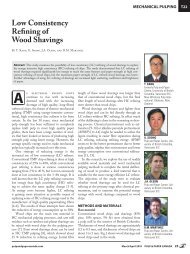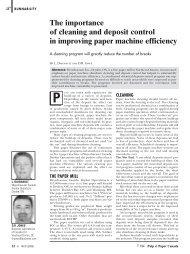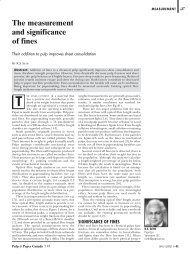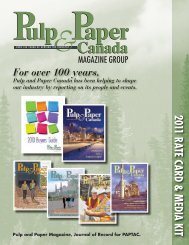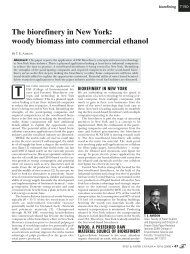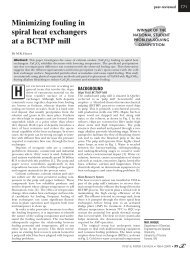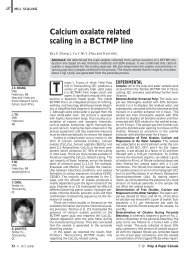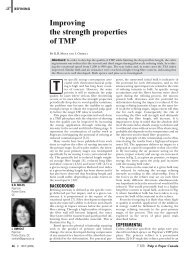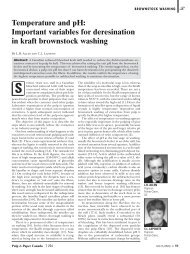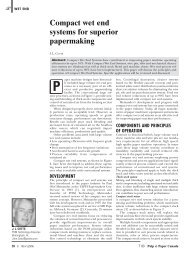SAWDUST - Pulp and Paper Canada
SAWDUST - Pulp and Paper Canada
SAWDUST - Pulp and Paper Canada
Create successful ePaper yourself
Turn your PDF publications into a flip-book with our unique Google optimized e-Paper software.
<strong>SAWDUST</strong><br />
TABLE I. Cooking conditions used for the four mill sawdust<br />
furnishes examined.<br />
Mill A B C D M&D<br />
Wood charge (o.d.), g 200 200 200 200<br />
L:W ratio* 3.5:1; 4.5:1 3.5:1 4.7:1 3.6:1<br />
AA, % (on o.d. wood) 21.5 17.0 21.0 20.0<br />
Sulphidity % (Kraft)** 33.0 38.0 24.5 30.0<br />
Sulphidity, % (PS) 16.0 19.0 12.3 15.0<br />
PS, % (on o.d. wood) 1.8 1.7 1.3 1.6<br />
AQ, % (on o.d. wood) 0.05 0.05 0.05 0.05<br />
Time to T (185°C), min 14 14 *** 12<br />
*** This ratio includes the moisture in the wood<br />
*** Sulphidity is expressed on an AA basis<br />
*** Time-temperature profile of conventional cooking (~90 min to<br />
170°C)<br />
TABLE III. Yield benefits in sawdust cooking from anthraquinone<br />
<strong>and</strong> polysulphide.<br />
Mill A* B C D M&D D conv ***<br />
PS, %** 1.8 1.7 1.3 1.6 1.6<br />
Yield benefit (%) at kappa number 30****<br />
KAQ 1.3 0.9 1.5 1.1 1.1<br />
PS 3.5 2.3 2.8 2.7 3.1<br />
PS-AQ 4.1 4.4 4.5 3.5 5.1<br />
Synergy –0.7 1.2 0.2 –0.3 1.0<br />
Yield benefit (%) at kappa number 20****<br />
KAQ 0.9 0.7 0.6 1.0 1.0<br />
PS 2.7 2.6 1.9 2.3 2.6<br />
PS-AQ 4.1 3.6 3.8 3.4 4.4<br />
Synergy 0.5 0.3 1.3 0.1 0.8<br />
*** L:W = 3.5:1<br />
*** PS charge, as sulphur, expressed on o.d. wood<br />
*** Time-temperature profile of conventional cooking (~90 min to 170°C)<br />
**** Yield benefit is relative to kraft process<br />
TABLE II. <strong>Pulp</strong> yields for sawdust cooking using anthraquinone<br />
<strong>and</strong> polysulphide.<br />
Mill A* B C D M&D D conv ***<br />
PS, %** 1.8 1.7 1.3 1.6 1.6<br />
Total yield (%) at kappa number 30<br />
Kraft 45.0 45.5 45.8 45.1 44.9<br />
KAQ 46.3 46.4 47.3 46.2 46.0<br />
PS 48.5 47.8 48.6 47.8 48.0<br />
PS-AQ 49.1 49.9 50.3 48.6 50.0<br />
Total yield (%) at kappa number 20<br />
Kraft 42.8 42.9 44.4 43.4 42.7<br />
KAQ 43.7 43.6 45.0 44.4 43.7<br />
PS 45.5 45.5 46.3 45.7 45.3<br />
PS-AQ 46.9 46.5 48.2 46.8 47.1<br />
*** L:W = 3.5:1<br />
*** PS charge, as sulphur, expressed on o.d. wood<br />
*** Time-temperature profile of conventional cooking (~90 min to<br />
170°C)<br />
TABLE IV. Approximate H-factors required to reach 20 <strong>and</strong><br />
30 kappa number.<br />
Mill A* B C D M&D D conv ***<br />
PS, %** 1.8 1.7 1.3 1.6 1.6<br />
H-factor to reach kappa number 30<br />
Kraft 1250 2425 1225 1650 1425<br />
KAQ 1100 2050 1000 1500 1225<br />
PS 1200 1925 1225 1750 1350<br />
PS-AQ 1000 1550 950 1500 1225<br />
H-factor to reach kappa number 20<br />
Kraft 1775 4000 1900 ≥2600 2500<br />
KAQ 1725 3800 1650 ≥2600 2150<br />
PS 1725 3500 1975 ≥2600 2500<br />
PS-AQ 1475 3100 1575 ≥2600 2400<br />
*** L:W = 3.5:1<br />
*** PS charge, as sulphur, expressed on o.d. wood<br />
*** Time-temperature profile of conventional cooking (~90 min to<br />
170°C)<br />
Effect of Chip Thickness on PS Performance:<br />
Furnish Preparation: A Domtar<br />
classifier was used to segregate the black<br />
spruce chips (obtained from whole logs<br />
debarked <strong>and</strong> chipped in Paprican’s pilot<br />
plant) into 2 to 4 mm <strong>and</strong> 6 to 8 mm<br />
thickness fractions. These chips were used<br />
in their wet form <strong>and</strong> cooking liquor was<br />
added under vacuum. H<strong>and</strong>-cut black<br />
spruce chips (2 mm <strong>and</strong> 4 mm in thickness,<br />
20 mm in width <strong>and</strong> 20 mm in<br />
length) were also generated from whole<br />
logs. These h<strong>and</strong>cut chips were air-dried,<br />
<strong>and</strong> prior to cooking, were steamed, followed<br />
immediately by a cold-water soak to<br />
ensure effective liquor impregnation/<br />
penetration. The cooking liquor was not<br />
added under vacuum. A Wiley mill<br />
equipped with a 3.2 mm screen was used<br />
to produce the sawdust; excess flour was<br />
removed from the sawdust using a 250-<br />
micron screen. The procedure for introducing<br />
cooking liquor was identical to<br />
that described for the mill sawdust experiments<br />
described above.<br />
RESULTS, DISCUSSION<br />
The softwood furnishes of four Canadian<br />
kraft mills (1 Eastern, one coastal BC, <strong>and</strong><br />
two interior BC) that pulp sawdust were<br />
evaluated in this study. For each mill furnish,<br />
the yield benefits of polysulphide<br />
(PS), anthraquinone (AQ) <strong>and</strong> PS-AQ were<br />
examined, relative to kraft. To make our<br />
results relevant to mill-scale application,<br />
mill cooking conditions were reproduced<br />
as closely as possible in our pilot plant.<br />
Complete sets of yield <strong>and</strong> delignification<br />
data are presented as figures for the<br />
work done with the furnish from Mill A<br />
<strong>and</strong> comparison data at kappa numbers<br />
20 <strong>and</strong> 30 are given in Tables II to IV for<br />
all the furnishes.<br />
Mill A: The yield vs. kappa number relationships<br />
for the four types of cooks, over<br />
the kappa number range 18 to 30, are<br />
shown in Fig. 1. Despite the rapid rise-totemperature<br />
of the sawdust cooking operation,<br />
polysulphide is clearly able to protect<br />
yield effectively. At a kappa number of<br />
30, the yield increase for PS (charged at<br />
1.8% on o.d. wood) relative to the kraft<br />
process, was 3.5%; at 20 kappa, the yield<br />
advantage decreased to 2.7% (Table III).<br />
The corresponding yield benefits of<br />
AQ at these two kappa targets were 1.3<br />
<strong>and</strong> 0.9%. For the combined application<br />
of PS <strong>and</strong> AQ, the yield increases at the<br />
higher <strong>and</strong> lower kappa numbers were<br />
both 4.1%. While a small synergistic effect<br />
[5] of PS-AQ (0.5%) was apparent at the<br />
lower kappa numbers, at kappa 30, the<br />
combined application of PS <strong>and</strong> AQ was<br />
neither additive nor synergistic (–0.7%).<br />
The delignification rates of the four<br />
types of cooks are compared in Fig. 2 <strong>and</strong><br />
Table IV. For both kraft <strong>and</strong> polysulphide<br />
cooks, AQ addition resulted in enhanced<br />
delignification at kappa 30; at kappa 20 its<br />
benefit was variable. The data in Table V<br />
indicate that, if kraft cooking provides the<br />
mill’s target kappa number of 28, the addition<br />
of AQ, PS <strong>and</strong> PS-AQ to the cook<br />
would decrease the kappa number to 25.5,<br />
27.0 <strong>and</strong> 21.5, respectively. As shown in an<br />
<strong>Pulp</strong> & <strong>Paper</strong> <strong>Canada</strong> T 2 105:1 (2004) ❘❘❘ 33


